The Jiji Joint Water Diversion Project is a key initiative in the Zhuoshui River basin aimed at enhancing water resource management. By constructing a permanent weir at Jiji, the project seeks to improve existing irrigation systems along the Zhuoshui River, ensuring a more stable water supply and reducing the reliance on groundwater extraction. This, in turn, helps mitigate land subsidence. Additionally, the project is designed to support industrial zones, including those on offshore islands, by channeling surplus water to meet their needs. Ultimately, the project aims to promote the sustainable use and management of the region’s water resources.
The Linnei Diversion Works serves multiple purposes, including irrigation, power generation, and industrial water supply. After water is drawn from the Jiji Weir, it is transported downstream via the South Bank Connecting Channel. At the Zhuo Main Canal’s Linnei No. 2 Intake, an octagonal diversion structure distributes water to various downstream users. In addition to the water supplied from the South Bank Connecting Channel, the Linnei Diversion Works also draws water from the Zhuo Main Canal’s Linnei No. 2 Intake. The completion of the Linnei Diversion Works and associated settling basin improvement projects will stabilize water intake, efficiently distribute water, and fulfill sedimentation functions, thereby enhancing the effective use of water resources for various users.
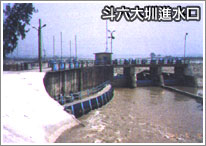
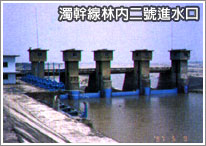
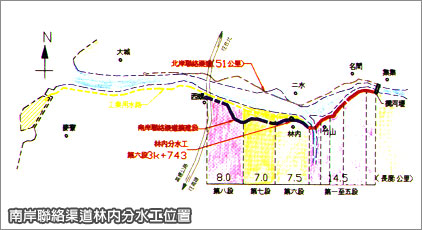
The Linnei Diversion Works is located at the start of the sixth section of the expanded South Bank Connecting Channel (at 3K+743). The planned diversion capacity is 90 CMS, with seven intake and diversion channels. The diversion structure is designed in an octagonal shape with a diameter of 100 meters. Its orthogonal inflow design reduces vortex interference and regulates water intake and discharge. Each side of the octagon measures 34.6 meters, and the total surface area of the diversion basin is 8,660 square meters, with a total storage capacity of 45,638 tons. The intake gates are set at a consistent elevation, with a sill 1.5 meters below the gate bottom, serving as a settling basin.
Inflow Sources:
(1) South Bank Connecting Channel: 90 CMS
(2) Zhuo Main Canal's Linnei No. 2 Intake: 54 CMS
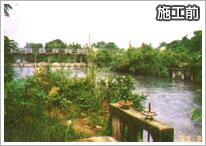
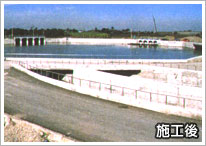
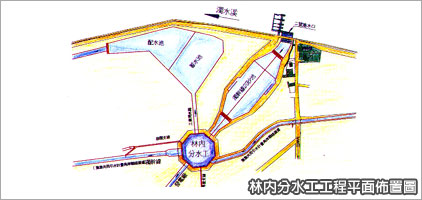
A settling basin is installed between the Linnei Diversion Works and the Zhuo Main Canal’s Linnei No. 2 Intake. The basin features a dual-tank design for alternating use, allowing one tank to be cleared of sediment while the other remains operational. The basin has a flow capacity of 54 CMS, with each tank measuring 30 meters wide and 120 meters long. The sediment capacity of each tank is 7,200 cubic meters, designed to capture sediment particles as small as 0.2 millimeters. Sediment is mechanically removed once the tank reaches capacity.
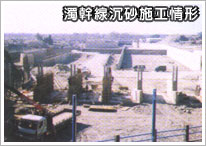
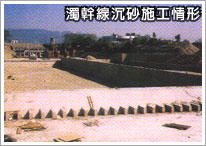


The Linnei Diversion Works, the largest multi-purpose diversion structure managed by this office, serves as an educational and demonstrative example of hydraulic engineering. It also provides a well-landscaped recreational space for nearby residents. Upon completion of the landscaping and greening projects, the hydraulic facilities will be transformed into a more inviting environment, promoting educational and recreational opportunities around water resource management.
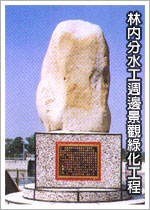
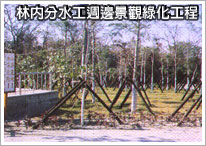
The South Bank Connecting Channel extends from the south bank settling basin to the starting point of the Yinxi Canal in Xiluo Township, Yunlin County, spanning approximately 38 km. The first 15 km generally follows public river land, while the remaining 23 km follows expanded sections of existing canal routes. The expansion, up to the starting point of Yinxi Canal, is being carried out by the Yunlin Irrigation Association in phases, divided into three sections (sixth, seventh, and eighth).
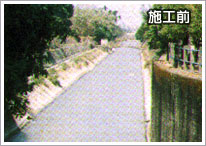
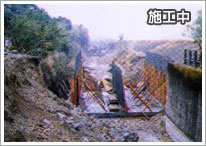
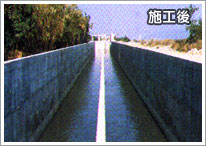
Section 6: From the Douliu Canal starting point to the Luchangke Canal (length: 7.5 km).
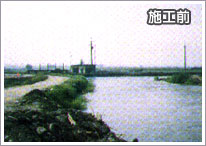
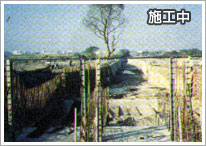
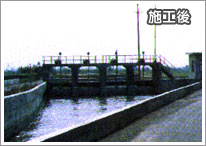
Section 7: From the Luchangke Canal starting point to its end (length: 7 km).
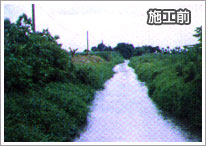
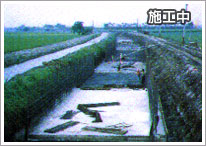
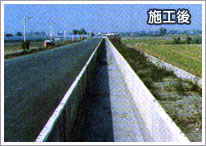
Section 8: From the end of the Luchangke Canal to the starting point of the Yinxi Canal (length: 8 km).
Due to land use constraints, the design and construction of the Linnei Diversion Works could not fully adhere to ideal hydraulic conditions. To evaluate the hydraulic performance after completion, hydraulic model testing was conducted by the Hydraulic Laboratory of the Planning Team at the Water Resources Bureau. The testing assessed the functionality of the diversion basin, water distribution stability, sedimentation issues, and gate operation, as well as methods to prevent sediment from entering the channels.
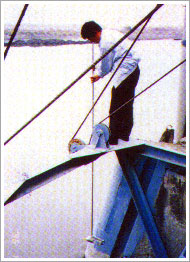
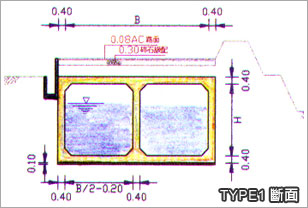
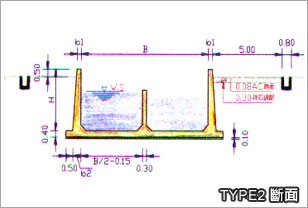
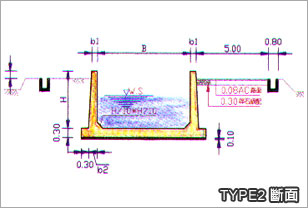
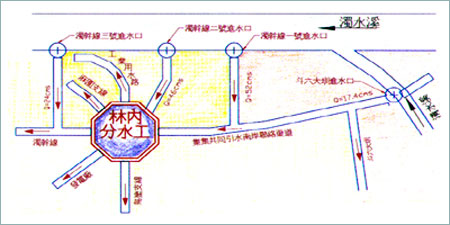

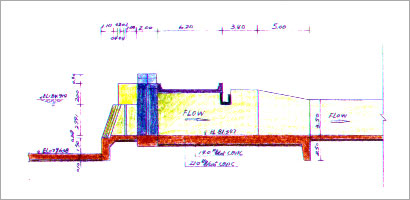
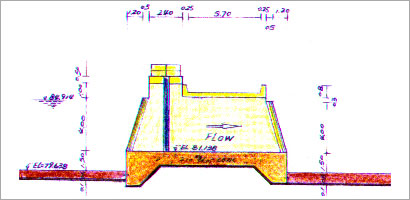
- Ensures efficient and equitable water distribution to all designated users.
- Improves water intake facilities, stabilizing irrigation sources and reducing water usage disputes.
- Supplies industrial water to the Yunlin Offshore Industrial Park, supporting industrial development.
- Reduces sediment concentration in the Zhuoshui River, decreasing maintenance costs and increasing operational efficiency.
- Protects power generation equipment, enhancing capacity and efficiency.
- Increases groundwater recharge, mitigating land subsidence and preserving land resources.
- Provides an educational environment for learning about hydraulic engineering.
- Creates landscaped and green recreational spaces for public use.
- Enhances agricultural production environments, promoting local industries, reducing population outflow, and supporting balanced regional development.
In September 1993, our office was tasked with improving the 23-kilometer expansion section of the South Bank Connecting Channel as part of the Jiji Joint Water Diversion Project. To address this demanding project, a planning and surveying team was quickly assembled in October. Drawing on the expertise of our engineering staff, we managed the planning, surveying, design, and supervision. The project’s success was achieved thanks to the oversight and guidance of the Water Conservancy Department (now the Water Resources Agency) and the strong cooperation of the contractors involved.